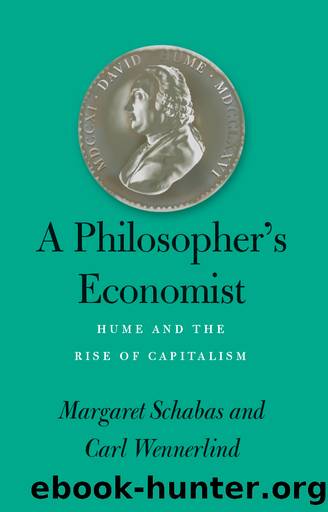A Philosopher's Economist by Margaret Schabas;Carl Wennerlind; & Carl Wennerlind

Author:Margaret Schabas;Carl Wennerlind; & Carl Wennerlind [Schabas, Margaret & Wennerlind, Carl]
Language: eng
Format: epub
Tags: PHI000000 Philosophy / General
Publisher: University of Chicago Press
Published: 2020-06-26T00:00:00+00:00
Debasement and Hoarding
Hume investigated whether changes in the money supply induced by other means than exports might also have positive effects on economic activity. One long-standing method of expanding the money supply was to debase the coinsâthat is, to remint and reissue them with the same nominal value but with a lower silver content. By diluting the silver and thus stretching the same quantity of metal over a greater number of coins, a debasement in effect injects money into the domestic economy. Hume claimed that the new coins âwould probably purchase every thing that could have been bought by the old; the prices of every thing would thereby be insensibly diminished; foreign trade enlivened; and domestic industry, by the circulation of a great number of pounds and shillings, would receive some encrease and encouragementâ (E-Mo, 288n). He noted that the success of such a recoinage was based on the false belief that the old and new coins retained their equivalences to other coins. âIn executing such a project, it would be better to make the new [silver] shilling pass for 24 halfpence [copper coins], in order to better preserve the illusion, and make it be taken for the sameâ (E-Mo, 288n). Hume thus pointed to the important insight in monetary theory that the value of a coin is primarily determined by its face value, by what passes for legal tender. Coins trade on âthe illusionâ that they are worth more than the metal of which they are composed.
Hume pointed to âthe frequent operations of the French king on the moneyâ (E-Mo, 287). The French Crown was notorious for using debasement as a fiscal strategy (E-PC, 638). In the fourteenth century, it issued eighty-five separate legal proclamations to alter the seigniorage or to debase the currency.29 Under Louis XIV, particularly during the latter part of his reign, the currency was debased or devalued dozens of times. According to Charles de Ferrère Du Tot, Hume noted, from 1683 until 1739, the French livre had lost its metallic value by 40 percent: âSilver was then at 30 livres the mark, and is now at 50â (E-Mo, 287). Hume also posited a universal principle: âIt was always found, that the augmenting of the numerary value did not produce a proportional rise of the prices, at least for some timeâ (E-Mo, 287). The temporal lag was confirmed in France in 1715: âIn the last year of Louis XIV money was raised three-sevenths, but prices augmented only one[-seventh]â (E-Mo, 287). Insofar as the nominal price of corn in France had stayed the same for more than fifty years, Hume declared, the real price had declined considerably. As a result, everyone had more bread on the table. Hume voiced skepticism about the accuracy of the figures, but âthe general observation, that the augmenting of the money in France does not at first proportionably augment the prices, is certainly justâ (E-Mo, 287n).
Tudor England endured a series of debasements that became known as the Great Debasement. However, the monetary
Download
This site does not store any files on its server. We only index and link to content provided by other sites. Please contact the content providers to delete copyright contents if any and email us, we'll remove relevant links or contents immediately.
International Integration of the Brazilian Economy by Elias C. Grivoyannis(74623)
The Radium Girls by Kate Moore(11619)
Turbulence by E. J. Noyes(7700)
Nudge - Improving Decisions about Health, Wealth, and Happiness by Thaler Sunstein(7240)
The Black Swan by Nassim Nicholas Taleb(6762)
Rich Dad Poor Dad by Robert T. Kiyosaki(6174)
Pioneering Portfolio Management by David F. Swensen(6078)
Man-made Catastrophes and Risk Information Concealment by Dmitry Chernov & Didier Sornette(5645)
Zero to One by Peter Thiel(5488)
Secrecy World by Jake Bernstein(4388)
Millionaire: The Philanderer, Gambler, and Duelist Who Invented Modern Finance by Janet Gleeson(4092)
The Age of Surveillance Capitalism by Shoshana Zuboff(3983)
Skin in the Game by Nassim Nicholas Taleb(3965)
The Money Culture by Michael Lewis(3846)
Bullshit Jobs by David Graeber(3826)
Skin in the Game: Hidden Asymmetries in Daily Life by Nassim Nicholas Taleb(3720)
The Dhandho Investor by Mohnish Pabrai(3560)
The Wisdom of Finance by Mihir Desai(3523)
Blockchain Basics by Daniel Drescher(3327)
